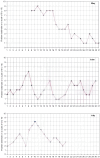Chronic pelvic pain of "unknown origin" in the female
- PMID: 38721452
- PMCID: PMC11075965
- DOI: 10.21037/atm-23-1758
Chronic pelvic pain of "unknown origin" in the female
Abstract
The remit of this review is confined to the experimental scientific works and surgeries based on the Integral Theory Paradigm (ITP). Chronic pelvic pain (CPP) is a major societal problem which is said to occur in up to 20% of women. The pathogenesis of CPP of "unknown origin" is said to be unknown and CPP is said to be incurable. According to the ITP, however, CPP is said to be mainly caused by the inability of loose or weak uterosacral ligaments (USLs) to mechanically support visceral nerve plexuses (VPs), T11-L2 and S2-4. These fire off de novo impulses, interpreted by the cortex as pain coming from the end organs. CPP, when it occurs simultaneously in multiple pelvic sites, is associated with uterine/apical prolapse (often minimal) and bladder symptoms such as overactive bladder (OAB), nocturia, retention. This combination of symptoms was described in 1993 as the "posterior fornix syndrome" (PFS). As such, CPP when associated with the PFS, is potentially curable by surgical repair of USLs. However, patients with CPP generally complain only of one symptom, CPP. This is known as the "Pescatori iceberg" effect. Other PFS symptoms are "under the surface" and must be sought out by direct questioning. The diagnostic algorithm is helpful in locating other associated symptoms. Definitive diagnosis of CPP, caused by USL laxity, is immediate alleviation of pain by mechanical support of USLs by using the speculum test or by tampons in the posterior fornix. Treatment of CPP can be non-surgical, by strengthening USLs by squatting exercises, supporting USLs mechanically with tampons or USL surgery. Coexisting bladder symptoms are (variously) improved or cured. URL for CPP https://www.pelviperineology.org/volume/36/issue/3.
Keywords: Chronic pelvic pain (CPP); speculum test; uterosacral ligaments (USLs); visceral nerve plexuses.
2024 Annals of Translational Medicine. All rights reserved.
Conflict of interest statement
Conflicts of Interest: All authors have completed the ICMJE uniform disclosure form (available at https://atm.amegroups.com/article/view/10.21037/atm-23-1758/coif). The series “Integral Theory Paradigm” was commissioned by the International Society for Pelviperineology without any funding or sponsorship. P.P. serves as an unpaid editorial board member of Annals of Translational Medicine from October 2022 to September 2024. The authors have no other conflicts of interest to declare.
Figures






References
-
- Martius H. Über einen häufigen gynäkolo- gischen Symptomkomplex. Arch Gynak 1938;166:332-5. 10.1007/BF02297210 - DOI
-
- Petros PE, Ulmsten U. The posterior fornix syndrome: a multiple symptom complex of pelvic pain and abnormal urinary symptoms deriving from laxity in the posterior fornix. Scand J Urol Nephrol 1993;27 Suppl 153:89-93. - PubMed
-
- Petros P. The female pelvic floor function, dysfunction and management according to the Integral Theory. 3rd ed. Heidelberg: Springer Berlin; 2010.
Publication types
LinkOut - more resources
Full Text Sources
Research Materials
